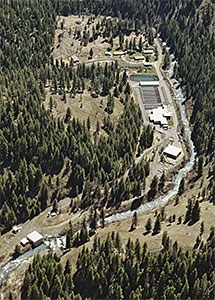The four federal dams on the largest tributary of the Columbia River, the Snake, took a toll on Snake River salmon and steelhead stocks. The dams, in order from the mouth of the Snake, are Ice Harbor, Lower Monumental, Little Goose and Lower Granite.
The Lower Snake River Compensation Plan, and the program developed consistent with it (the LSRCP) is an effort to replace some of those losses through production of salmon and steelhead at hatcheries. Congress authorized the LSRCP in the Water Resources Development Act of 1976 (90 Stat. 2917), Public Law 94-587). The LSRCP oversees the operation and maintenance of ten hatcheries and 16 satellite facilities on Snake River tributaries in southeastern Washington, northeastern Oregon and central Idaho.
In addition to fish incubation facilities, the LSRCP includes facilities to trap adult fish and acclimate and release juvenile fish in the lower Snake, Salmon, Clearwater, Grande Ronde, Imnaha, Tucannon, Touchet, and Walla Walla river subbasins. According to the legislation, these facilities are intended to produce enough smolts to return 18,300 fall Chinook, 58,700 spring and summer Chinook, 55,100 steelhead and 93,000 pounds of trout annually.
The plan is administered by the U.S. Fish and Wildlife Service. It dates to assessments of fish and wildlife losses attributable to the four lower Snake River dams conducted in the mid-1960s. The assessments led to a 1972 report by the Fish and Wildlife Service and the National Marine Fisheries Service to the U.S. Corps of Engineers, which operates the four dams. In 1975, the Corps reported to Congress, and the plan was authorized in the Water Resources Development Act the following year.
The basis of the plan is to compensate for the loss of 15 percent of the downstream-migrating juvenile salmon and steelhead at each of the dams. This amounts to a cumulative loss of 48 percent of the pre-dam runs. The plan assumes that the remaining 52 percent of the pre-dam runs would be maintained or increased through natural production and aided by mitigation efforts such as modifying turbine intake screens at the dams, installing devices on spillways to reduce dissolved gas below the dams, barging and trucking smolts downstream and improving spawning and rearing habitat.
In 1998, the program funded a symposium to address its own success, and the conclusion of independent scientists and stakeholders was that in most years the goals of the hatchery program and the mitigation effort have not been met. These include goals for the numbers of adult salmon and steelhead needed for broodstock collection, and also for juvenile fish production. At the review, participants said neither the hatchery program nor the effort to increase the number of naturally spawning fish had done as well as anticipated. Chinook salmon production has shifted from traditional hatchery practices to supplementation because of the low number of fish; hatchery steelhead populations did well, but naturally spawning steelhead continued to decline and were listed as threatened species under the ESA.
Given these developments, in 2001 the Independent Scientific Review Panel (ISRP) of the Northwest Power and Conservation Council reviewed the program and questioned “. . . the present day applicability of the original authorizing legislation for the LSRCP.” According to the ISRP, it may be worth investigating, at a policy level, “. . .whether the mismatch between the original authorizing language and the tasks that the Lower Snake River Compensation Program faces today creates an obstacle to the program’s ability to address present concerns.” By late 2006, such a policy-level investigation had not occurred.




